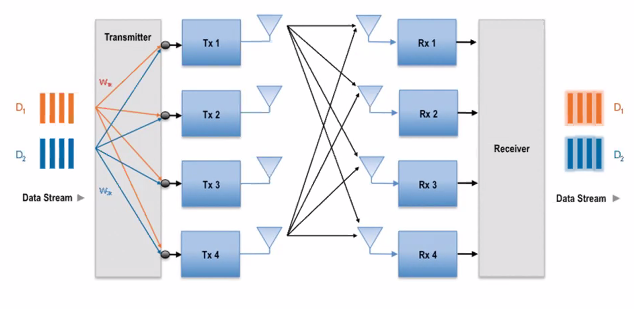=== Wi-Fi ===
Wi-Fi 는 레이어 1,2 가 같이 있다고 생각하면 된다.
1. What is Wi-Fi?
• A name for local area wireless computer networking technology
• Based on IEEE 802.11 standards on Wireless Local Area Networks (WLANs) : 이게 정식 이름이고 Wi-Fi는 제품명으로 출시한 이름이다.
• Used as a synonym for WLAN (Wireless LANs)

IEEE 802.11 standards
• Defines physical and data link layer techniques
• Physical layer
– Modulation, coding techniques
• Data link layer
– Medium access control

Data Link와 Physical 부분만을 다루고 있다. 왜냐하면 이 두 부분의 차이가 매체로 인해 크게 바뀌기 때문
무선같은 경우에는 Medium access control이 필요하다. 왜냐하면 이게 없으면 옆에 있는 사람도 무선기기로 받을 수 있기 때문
802.11 standards: The main stream
- Legacy 802.11 (1997)
- 900MHz band, 2 Mbps
- Frequency hopping spread spectrum (FHSS)
- Patented by Hollywood star Hedy Lamarr
- 802.11b (1999)
- 2.4GHz band, 11Mbps
- Direct sequence spread spectrum (DSSS)
- 802.11a (1999)
- 5GHz band, 54Mbps
- Orthogonal frequency division multiplexing (OFDM)
- 802.11g (2003)
- 2.4GHz band, but OFDM and 54Mbps
- compatible with 802.11b
- 802.11n (2009)
-2.4GHz and 5GHz band- OFDM
- up to 600Mbps with 40MHz channel, 4x4 MIMO
- 802.11ac (2014)
- Gigabit throughput
- Wider RF bandwidth, more MIMO streams, high-density
modulation
버전이 나오는데 802.11은 바뀌지 않고 뒤의 알파벳만 붙는다. 그런데 중간에 빈것들은 사실은 버전이 나오기는 했는데 main stream 연구주제가 아니라서 그렇다.
802.11 standards: others
• 802.11e: QoS enhancements
• 802.11i: security
• 802.11k: radio resource management
• 802.11p: vehicular environments (WAVE)
• 802.11s: mesh networking
• 802.11u: interworking with cellular systems
• ... many othersIntroduction to Computer Networks
=== Wireless Channel ===
1. Wireless Channel
• Signal transmitted onto the wireless channel from a transmit (TX) antenna
• Signal travels through the air and is received at the receive (RX) antenna

신호를 보낸다는 것은 Tx -> Rx인 형태이다.
Signal Attenuation
• As the signal travels through the air, its power is attenuated
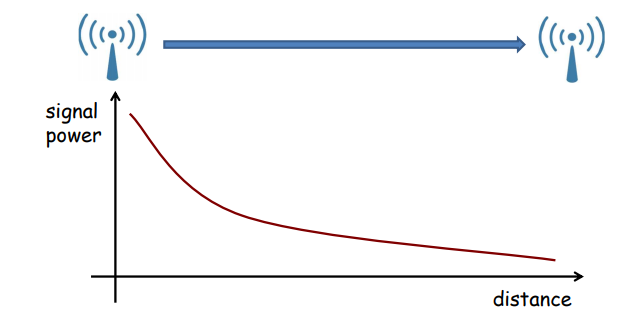
전파를 쏘면 일정 세기로 전파를 보낸다. 그런데 이 전파가 주변으로 퍼진다. 그래서 에너지가 공기중으로 퍼진다. 신호의 세기가 거리에 따라서 줄어들게 된다.
Pathloss
• The receiver (Pr) is basically a function of transmit power (Pt) and the distance between transmitter and receiver (R)

• Signal attenuation based on distance is called pathloss
거리에 따라서 신호가 감쇄하는 현상을 보고 pathloss라고 부른다.
이를 수식으로 표현한 것들 중 하나는 Friis propagation model이다.
R^2에 반비례한 수식이고 Pr/Pt 가 작다는 것은 수신신호 세기가 작아졌다는 것을 이야기 한다. 환경에 따라서 모델들이 달라진다.
- Gt = transmit antenna gain, Gr = receive antenna gain, λ = wavelength
Receiver Sensitivity
수신자가 데이터를 받는데 중요한 것은 receiver sensitivity는 수신자의 수신감도이다. 여기에서는 -90이라고 적히어 있는데 -90 미만으로 떨어지면 받을 수 없다는 것을 이야기 한다. 즉 들리냐 안들리냐의 문제이다.
• Receive antenna can receive the signal only when the signal power is stronger than the receiver sensitivity
– Receiver sensitivity depends on the hardware

SNR
• Even if signal is received stronger than RX sensitivity, whether the receiver can decode the signal depends on the SNR (Signal-to-Noise Ratio)

Receiver sensitivity는 절대적으로 신호세기를 말한다. 하드웨어가 감지할 수 있는 신호의 세기를 Rx sensitivity라고 부른다. 만약 수신된 신호가 이 기준보다 낮아지면 감지를 못한다. 어떤 신호가 Rx보다 더 높은 수준으로 들어와 감지하더라도 수신할 수 있을지 없는지는 SNR에 달리어 있다.
내가 수신하고자 하는 신호의 세기 대비 다른 신호의 세기의 비율을 SNR(Signal-to-Noise Ratio)이라고 부른다. 그것이 높아야지만 신호를 제대로 받을 수 있다.
• Sometimes, the term SINR (Signal-to-Interference-plus-Noise Ratio) is used

또는 SINR이라고 부른다.(Signal-to-Interference-plus-Noise Ratio) interference와 noise를 따로 나누어서 말하기도 한다.
SNR and Signal Decoding
결국 어떤 Frame을 송신자로부터 수신자로 전달시 수신자가 잘 받을 수 있느냐는 SNR에 달리어 있다.
최소 SNR이라는 것이 있는데 그것을 높은 속도로 보낼 수록 SNR이 높아진다.
SNR과 신호수신사이에는 관계가 존재한다.
• The minimum SNR required for decoding depends on modulation and coding
• Higher modulation and coding level requires higher SNR
SNR이 중요한 이유는 modulation이 높아질 수록 필요한 SNR이 높아진다.
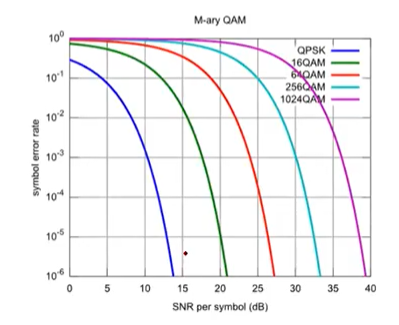
x축이 SNR이고 y축이 symbol error rate이다. 여기의 그래프에서 중요한 것은 결국 언제 error ratio가 줄어들기 시작하냐는 것이다. QPSK는 SNR이 낮더라도 에러의 비율이 크게 낮지만 1024QAM은 SNR이 높아저야 받을 수 있다.
Units for signal strength: decibel (dB)

데시벨이라는 것은 세기의 비율을 log로 나타낸 것이다. P라는 것은 파워, 전파의 세기이다.(mW)
• indicates ratio of two signal strengths
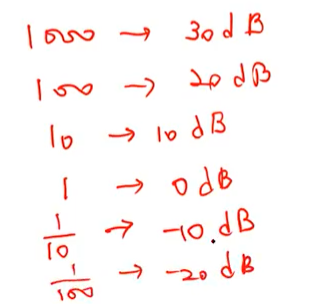
이와 같이 두개의 strength의 비율을 log로 나타낸것이 dB이라고 할 수 있다.
Example
• Suppose a signal travels through a transmission media and its power is reduced to one half. This means that P2 = 0.5P1. In this case, the attenuation can be calculated as:
파워가 반으로 줄었다면 신호 감쇄가 얼마가 일어났다고 할 수 있는가?

P1이 송신할때의 세기이고 P2는 전달하다가 신호세기가 줄어든것이다. 그래서 -3dB가 되었다는 것은 반으로 줄었다는 이야기 이다 반대로 2배가 되었다면 3dB가 된다.
4배가 되었다고 하면 6dB가 되었다고 이야기 한다.
• A loss of 3dB (-3dB) is equivalent to losing one-half the power
• A signal travels through an amplifier and its power is
increased 10 times. This means that P2 = 10P1. In this case, the amplification can be calculated as:

dBm

dBm(W)을 이야기 한다. 그래서 dBm은 mili 단위를 log로 나타낸 것이라고 생각하면 된다. 이건 비율이 아니고 절댓값이다.
어떤 신호가 20dBm, 30dBm 두개가 있었을때 이 둘은 100mW와 1000mW의 차이이다. 이때 그냥 따로 연산 필요없이 서로 빼주면 된다. 그럼 10dB차이라고 한다. 어라? 왜 dBm이 아니고 dB인가? 왜나하면 dBm은 로그이고 이 둘을 빼주기 때문에 로그에서 빼기는 곧 나누기가 된다. 그래서 10dB 차이가 난다고 이야기 하는 것이다.
Example
• The loss in a cable is usually defined in decibels per kilometer (dB/km). If the signal at the beginning of a cable with -0.3dB/km has a power of 2mW, what is the power of signals at 5km?

dB는 W로 바꾸는 과정을 보여준다.
Signal-to-Noise Ratio (SNR)
• SNR = signal power / noise power
• Units may be in W scale (ratio) or dB scale
Exercise
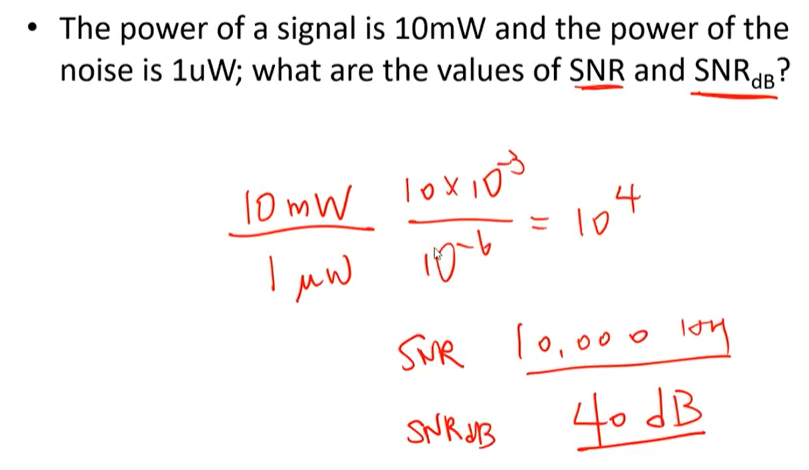
뭐로 적으로고 말을 안해주었기에 대충 이렇게 된다고 보면 된다.
Fading
수신신호 세기에 영향을 미치는 것은 pathloss, Fading 두가지가 있다.
Fading은 다른 것에 의해서 영향을 받은 것을 이야기 한다.
• Factors affecting received signal power
– Pathloss
– Fading
• Fading
– Deviation of attenuation affecting a signal
• Types of fading
– Slow fading (large-scale fading, shadowing)
– Fast fading (small-scale fading)
Slow vs. Fast Fading
Slow는 장애물 떄문에 fading이 발생하는 경우이다. 에를 들어서 핸드폰과 기지국 사이에 아무것도 없으면 Slow Fading이 없다고 볼 수 있으나 반대로 중간에 아파트가 있으면 신호 감쇄가 발생한다.
Fast fading은 건물안에서 사람이 AP와 통신시 AP에서는 여러 갈래로 신호를 보내게 된다. 이때 벽에 붙이치는 신호가 있을 수 밖에 없다.
직접적으로 오는 신호는 LOS 그 외는 NLOS라고 한다. 이때 NLOS와 LOS는 delay가 발생하게 된다.
전파는 합치어지는데 운 좋게 두 전파가 맞으면 강화되지만 반대로 전달되면 상쇄가 일어난다.
• Slow (large-scale) fading
– Large obstruction such as hill or large building obscures the main signal path between the transmitter and the receiver
– Modeled using log-normal distribution
• Fast (small-scale) fading
– Caused by multipath propagation
– Amplitude and phase change imposed by the channel varies considerably over the period of use
Pathloss and Fading
결국 pathloss, slow-fading, fast-fading 세가지가 섞여서 우리에게 오게 된다.
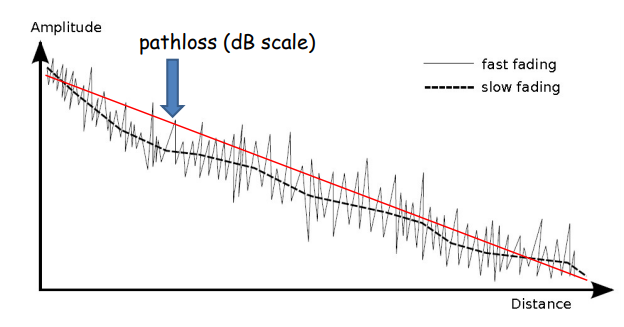
=== Wi-Fi: Physical Layer Aspects ===
1. Physical Layer
• Signal generation from bits
• Recovery of bits from the received signal
• Tightly coupled with physical medium
• Modulation and coding scheme (MCS)
physical layer의 역활은 내가 보내야 하는 Data를 매체 맞는 신호로 바꾸어서 보낸다. 수신자 측은 그것을 받아서 복원해낸다.
이것을 위해서 중요한 것이 MCS라는 것이다. Modulation은 0과 1을 어떻게 전파신호로 바꿀까이다. (modulation의 반대는 deModulation) modulation + deModulation = Modem
Coding은 error correction code이다. redundancy가 높일 수록 error correction이 높아진다. coding scheme는 error redundancy를 높이면 속도는 빨라지지만 복원은 못할 수 있다. 낮추면 속도는 느려도 복원할 수 있다.
Modulation
• Process of varying one or more properties of carrier signal with a modulating signal which contains information
• Carrier signal: a high frequency signal for carrying
data
– E.g. WLAN channels

표준에 보면 wifi의 채널이 위와 같이 정의되어 있다. 채널을 여러개를 두어서 옆에있는 wifi끼리는 다른 채널을 사용하면 동시에 전송이 가능해진다. 이때 대역폭이 약 20MHz로 되어있다. 또한 채널끼리 조금씩 떨어진 것도 확인할 수 있다.
• ASK
• FSK
• PSK
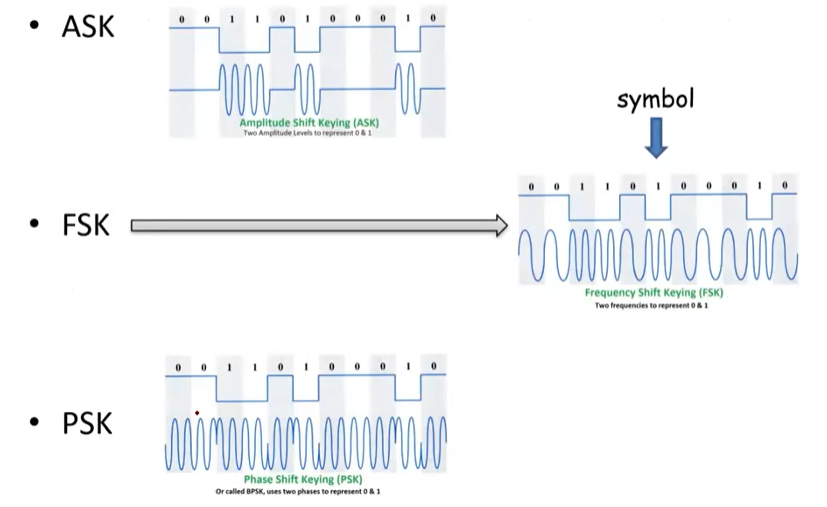
전파신호를 갖다가 0과 1을 구분해준다. 그러려면 모양이 달라야 한다. A는 진폭, F는 주파수, P는 위상으로 밖에 바꿀것이 없다.
• QAM (Quadrature Amplitude Modulation)
– PSK + ASK
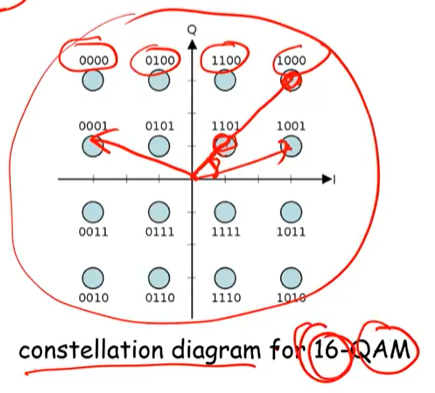
constellation diagram for 16-QAM
PSK, ASK를 이용해서 신호를 만든다.(주파수는 채널용) 위 그림에서 포인트가 16가지가 있다. 그때 포인트까지의 거리가 진폭이고 각도가 위상이다.
1000, 1101은 진폭은 다른데 위상은 같다.
암튼 진폭과 위상으로 16가지의 신호가 생긴다. 그럼 그 신호를 가지고 4bit를 전송할 수 있다.
16가지가 있어서 16-QAM이라고 한다.
Modulation used in Wi-Fi
• BPSK (Binary PSK): encode 1 bit on a symbol
– 2 different signals
0과 1만 구분
• QPSK (Quadrature PSK): encode 2 bits on a symbol
– 4 different signals
4가지 구분
• 16-QAM: encode 4 bits on a symbol
– 16 different signals
16가지 구분
• 64-QAM: encode 6 bits on a symbol
– 64 different signals
64가지 구분
그래서 더 높은 걸 쓰면 속도가 보다빨라진다. 하지만 높으 QAM은 오히려 구분하기 어려울 수 있기 때문에 SNR에 맞추어서 QAM을 조절한다.
Coding (Channel Coding)
• Insert error-correcting codes (ECC) in order to make the message tolerable to errors
• E.g. Hamming (7,4) code
– Corrects 1-bit error in a 7-bit message
• Coding rate
– Ratio of data bits in the message
– E.g. 3/4 coding rate: 75% data, 25% ECC
MCS (Modulation and Coding Scheme)
• Defines modulation scheme and coding rate
– The transmitter should tell the receiver which MCS level it is usingIntroduction to Computer Networks
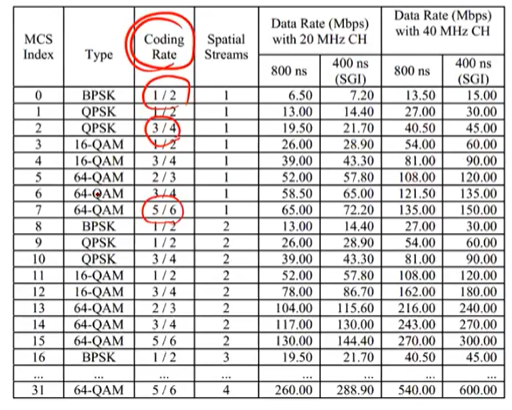
ECC는 error-correction code인데 우리는 coding rate만 생각하면 된다. 1/2는 data가 10bit이면 redundancy가 10bit이다. 3/4는 3/4가 data이고 1/4가 error correction code이다.
또 한가지 볼 것은 modulation type 과 codeing rate를 보고 index를 나눈다. link quality에 따라서 MCS를 알아서 전송한다.
결국 속도는 대역폭, modulation, coding rate에 비례한다고 생각할 수 있다.
데이터 전송시 MCS 인덱스 중 하나를 골라서 보내게 된다. SNR에 따라서 보내게 된다.
Spatial Streams는 아래에서 나오는 MIMO부분을 이야기 한다.
• Selection of MCS level depends on the link quality
• Higher MCS level requires higher SNR
• Since the SNR can change dynamically over time, MCS level is changed adaptively
MIMO (Multiple Input Multiple Output)
전송율이 어떤 영향을 미치는가만 보자
• Use of multiple antennas at both the transmitter and
the receiver to improve communication performance
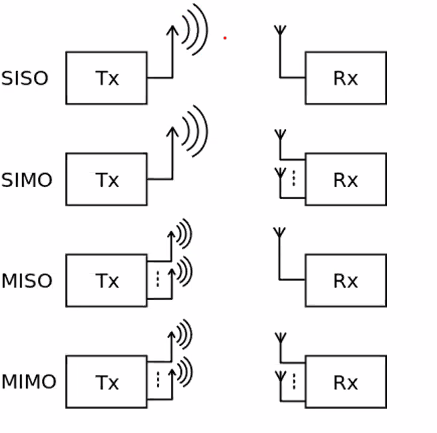
안테나를 여러개를 사용해서 전송율을 높이어 보겠다.
S(single), M(Multiple), I(in), O(out)
SISO(1:1), SIMO(1:m), MISO(m:1), MIMO(m:m)
MIMO: advantages
• Array gain: improves spectral efficiency
– Transmit different data on multiple antennas
• Diversity gain: improves link reliability
– Transmit the same data on multiple antennas using space-time coding

송신자가 보낸것의 어느쪽 방향이 높아질지 모른다. 그래서 세기가 더 쌘곳을 고른다. 이것을 Diversity gain이라고 부른다.
MIMO: array gain
• M transmit antenna, N receive antennas
• Array gain: min (M, N)
• E.g.) 2 TX antennas and 4 RX antennas
-> 2x transmit rate compared to SISO

Tx, Rx 안테나 둘이 서로 다른 신호를 보낸다. spacial coding을 잘해서 이것을 복원할 수 있도록 한다.
Physical layer: OFDM
• A specialized FDM (frequency division multiplexing)
• Sub-carriers are chosen so that they are orthogonal to each other – they do not interfere with each other
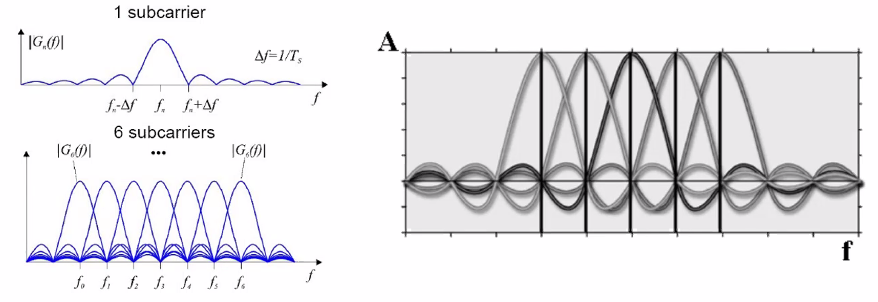
데이터를 실재로 어떻게 전송하는가?
20MHz를 사용한다면 보다 작은 주파수로 나누어서 데이터를 실는다.
Why OFDM?
• Can easily adapt to channel conditions
• Robust against narrow-band co-channel interference
• Robust against inter-symbol interference (ISI) and fading caused by multipath propagation
• High spectrum efficiency compared to spread spectrum techniques
802.11n OFDM – 20MHz channel
• 20MHz channel, divided into 56 subcarriers
– 52 subcarriers used for data, 4 subcarriers for pilot
– Each subcarrier: 312.5kHz, signal bandwidth: 17.5MHz
– Symbol duration: 3.6us (guard interval: 0.4us)
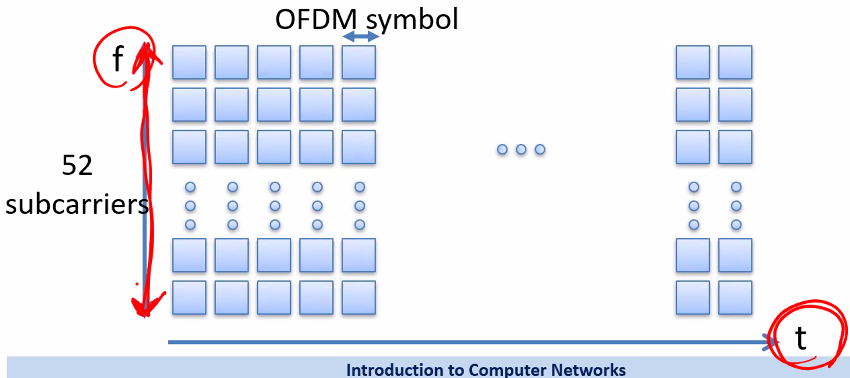
그림과같이 20Mhz를 가지고 와서 56개로 나눈다. 그중에 또 4개는 pilot signal이라고 해서 사용하지 않는다.
pilot subcarrier에는 송수신자간에 이미 알고 있는 신호를 보낸다.
각각의 subcarrier에 bandwidth가 있다.
symbol duration 주파수별 간격은 3.6us이라는 것이다. guard interval은 신호 사이의 간격이다.(0.4us)
결국에는 이렇게 나누어서 작은 네모하나에 데이터가 들어간다. 들어가는 데이터는 BPST, QPSK 등등으로 나누어진다.
802.11n OFDM – 40MHz channel
• 40MHz channel, divided into 114 subcarriers – 108 subcarriers used for data, 6 subcarriers for pilot – Each subcarrier: 312.5kHz, signal bandwidth: 35.625MHz – Symbol duration: 3.6us (guard interval: 0.4us)
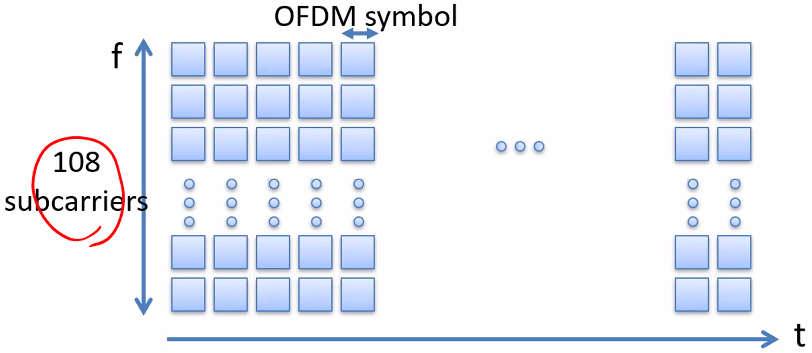
40MHz를 사용하면 20MHz의 2배보다 약간 적게 더 보낼 수 있다.
802.11n OFDM – Modulation & Coding
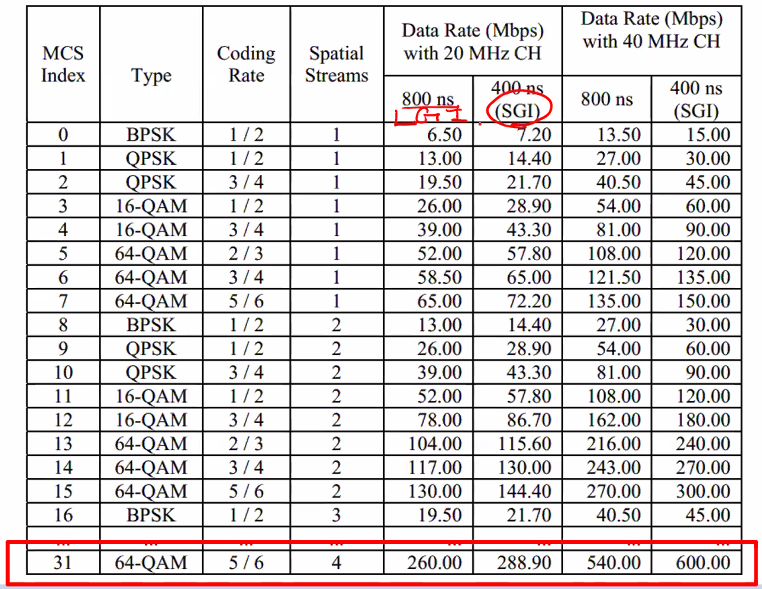
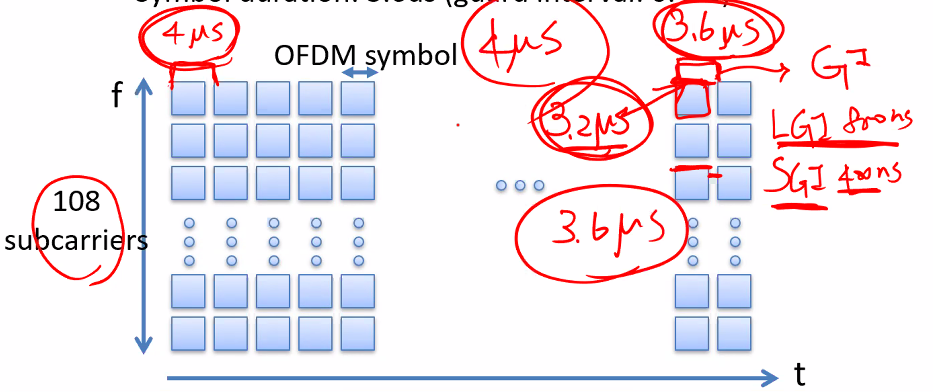
위의 SGI, LGI로 나뉘는데 이건 패킷간의 간격을 400ns/800ns로 나눌지를 선택하는 부분이다.
빨간부분의 600은 전송속도(Mbps)
Achieving 600Mbps
600MBS를 어떻게 구하는가?
• Modulation: 64QAM
– 6 bits are coded per subcarrier
네모칸 하나에 6bit를 보낸다.
• Coding: 5/6
– 16.6% redundant bits for error correction
1/6은 redundant이고 나머지는 데이터이다.
• Data bits per OFDM symbol (40MHz)
– 6 x (5/6) x 108 subcarriers = 540 bits
40MHz를 사용하때 세로축으로 108개의 캐리어를 사용한다. 그리고 위에서 한칸에 6 x (5/6)이라고 했으니 540bit가 한 번에 전달되는 것이다.
• Number of OFDM symbols per second = 277,777
SGI를 쓴다고 할때 네모칸이 1초에 몇개가 들어가는가이다. 이때 SGI 3.6us로 1초를 나눈값이 277777인 것이다.
• Data rate: 540 x 277,777 = 150Mbps
MIMO -> 150Mbps * 4 = 600Mbps
Achieving 600Mbps
- MIMO (Multiple Input Multiple Output)
- Linear capacity growth with minimum number of antennas
- 4x4 MIMO -> 4 times capacity compared to SISO
– Use 4x4 MIMO: 150Mbps -> 600Mbps
- Linear capacity growth with minimum number of antennas
